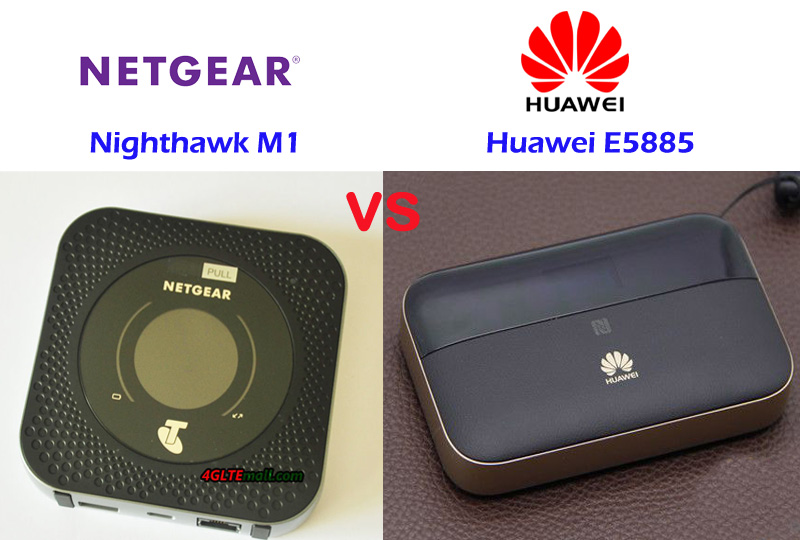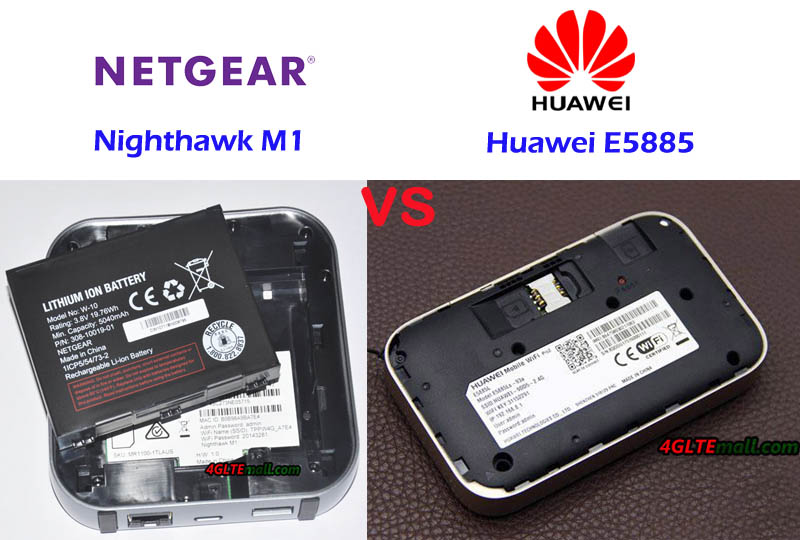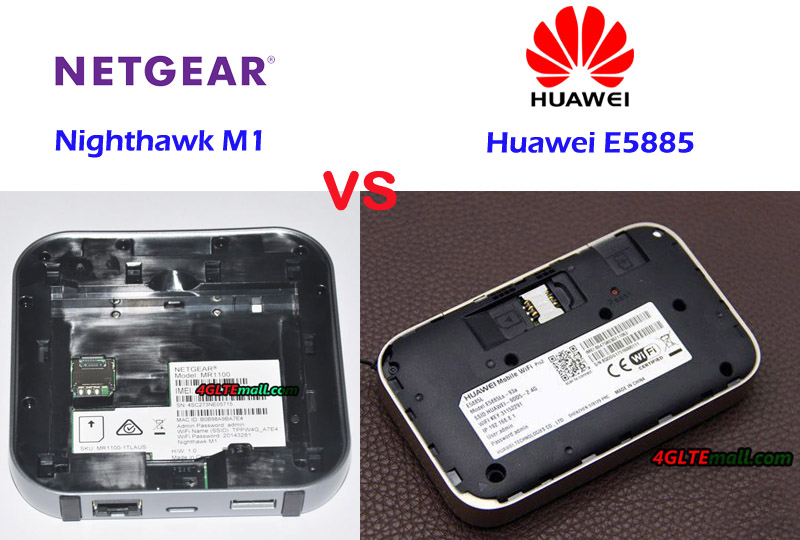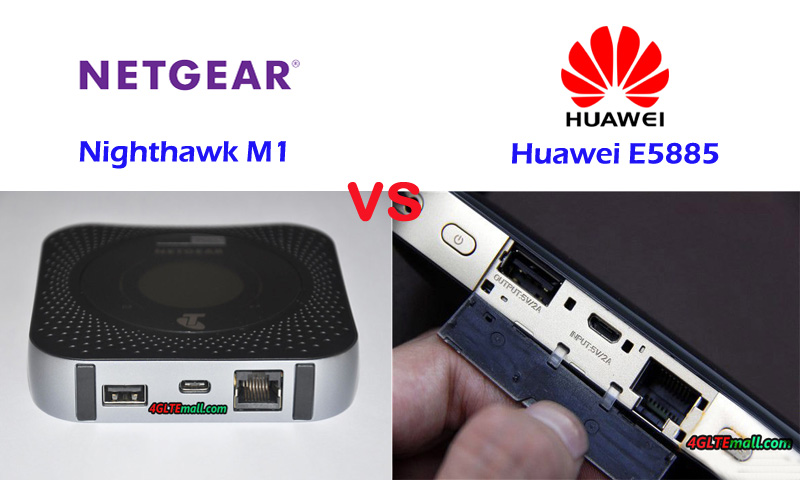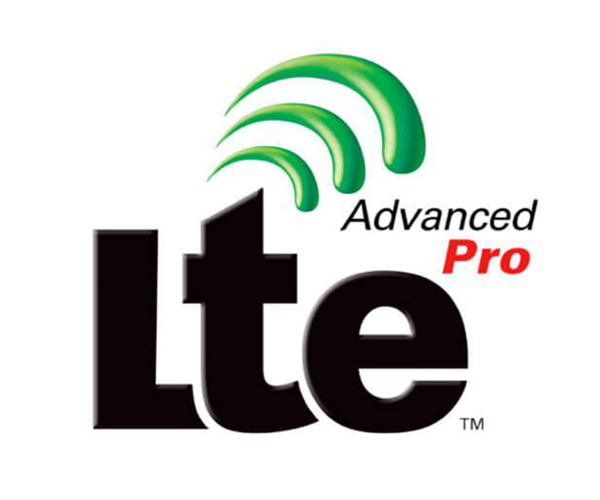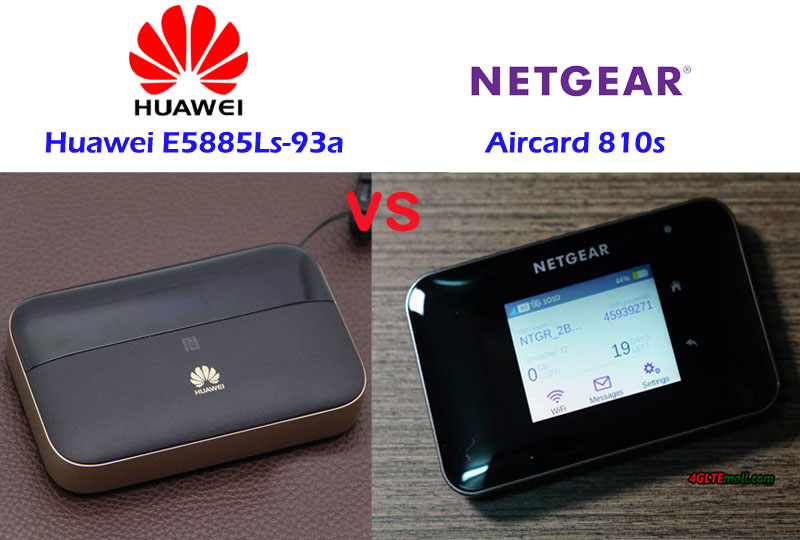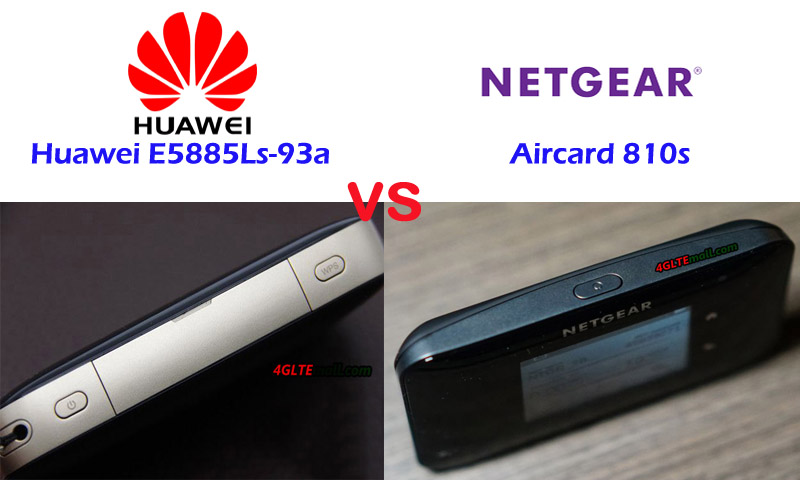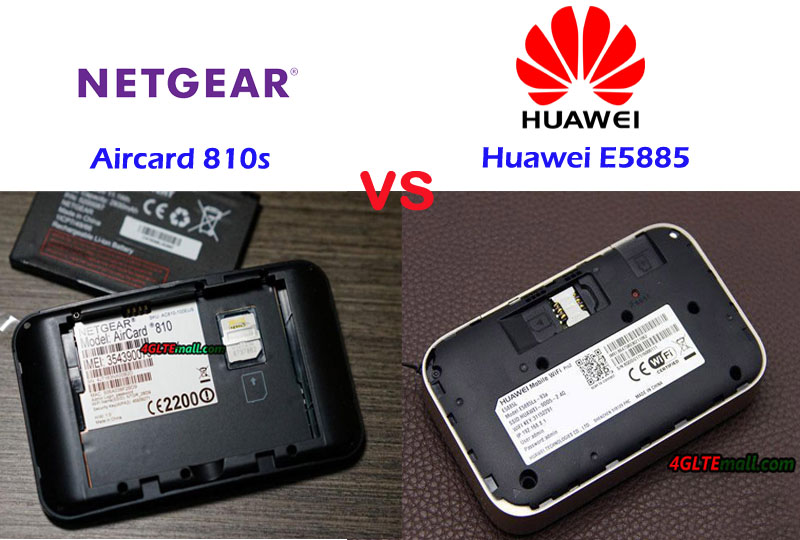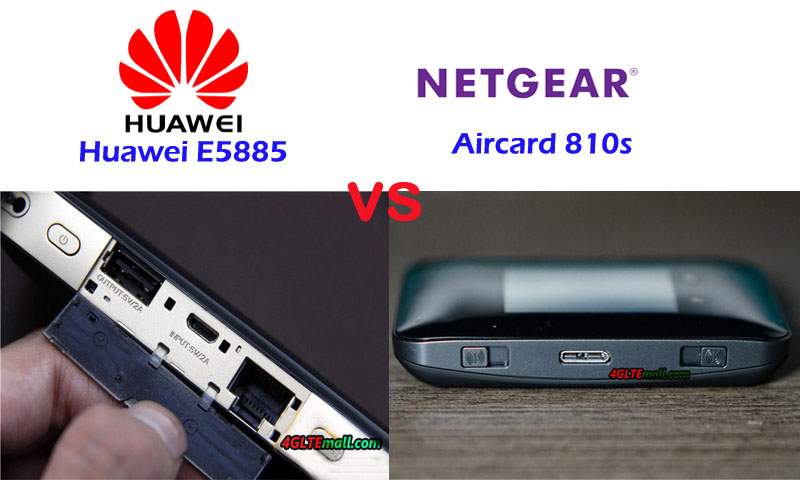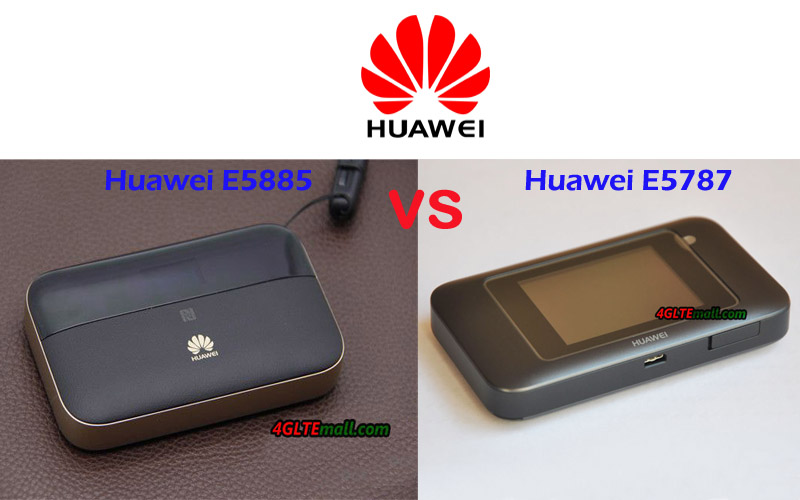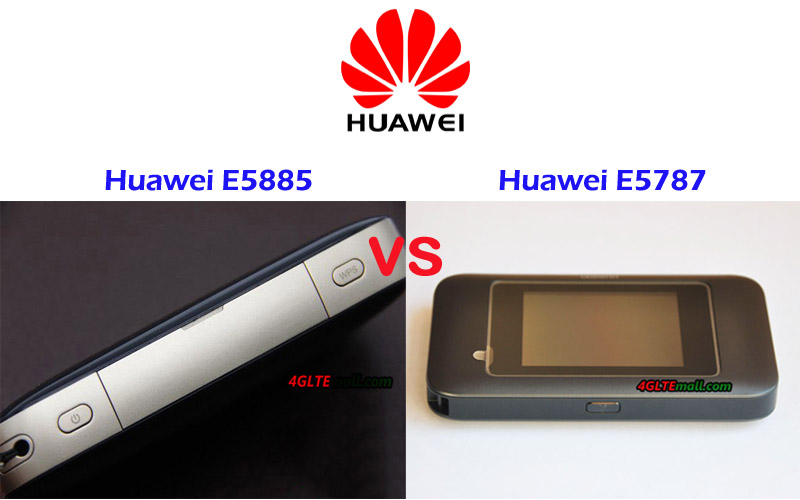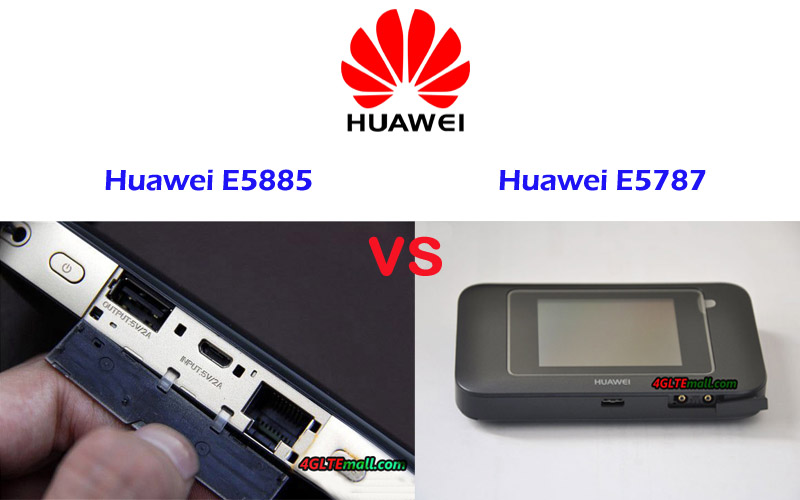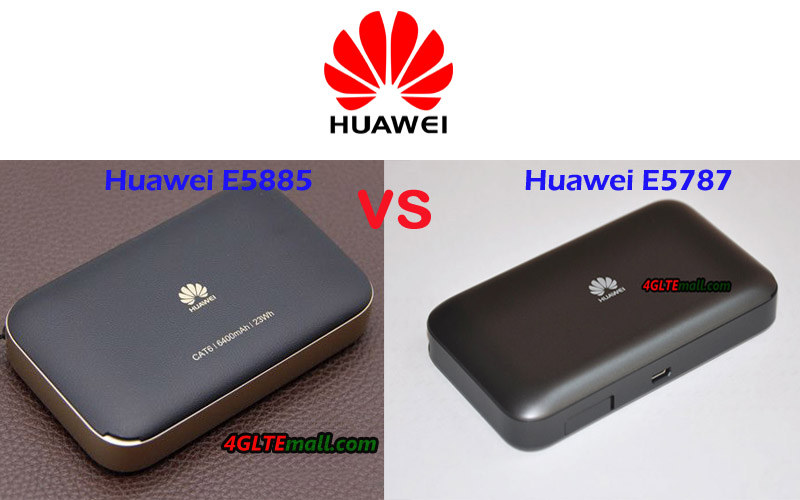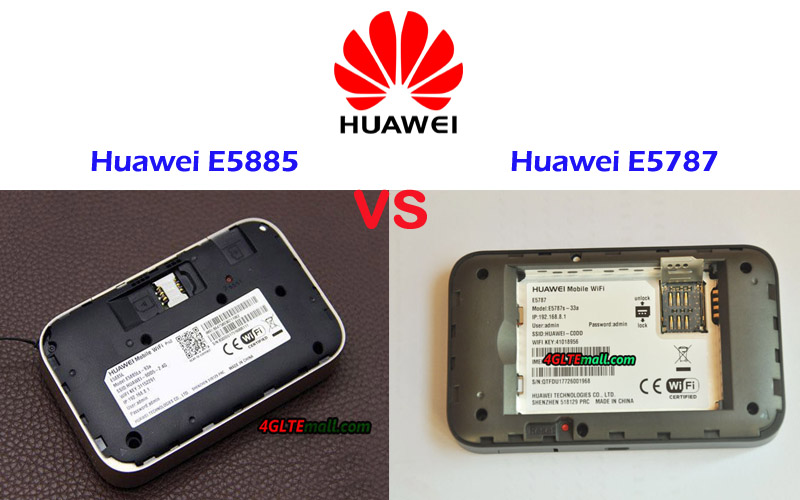LTE Broadband
-
Huawei E5885 VS Netgear Nighthawk M1
In past years, 4G mobile routers with SIM card slot are becoming more and more well-known because they are of small size and can be easily taken in a handbag or in a pocket. Nowadays, more and more people would prefer the 4G router with Ethernet port , which would provide one more option for internet connection. What's the most, the manufacturers typically set up the 4G routers with Ethernet with large battery pack, which makes the device more expensive. Huawei is the first manufacturer to release its 4G mobile router with Ethernet port, and now the Netgear follows. Huawei E5885 is the latest 4G mobile hotspot with Ethernetand Netgear presents the Nighthawk M1 as its first 4G router with Ethernet. Someone may ask: what's the difference between Huawei E5885 and Nighthawk M1 ? Which one is better? You may find the answers after reading this article.
Huawei E5885 Nighthawk VS M1 Appearance and Interface
Actually, before the Huawei E5885 was presented, Huawei had released a few mobile hotspots with Ethernet port such as E5151, E5730, E5351, E5770, E5771, which are a series mobile router with Ethernet. It has been proved this series of MiFi hotspots are very popular in the end-users. Now the upgraded Huawei E5885 is available with more advanced features and cool design. On the front of E5885, the upper part is LED screen while the lower part is leather material with Huawei logo. The touch feels in hand is very much better than the predecessor models. And it’s much thicker than the mobile hotspot E5770 and E5771. The power button, WPS, and the Interfaces are located at the top edge side of the body. The Ethernet port and USB ports are covered by a square cap, which you have to open it to see. The back cover could be removed, however, like the Huawei E5786, the battery is built-in and non-changeable. The Mirco SIM card slot and SD storage card slot are available with the reset button.
Unlike its predecessor of Netgear mobile router, Nighthawk M1 also has a thick body. On the front, there is a round screen, like E5885, it’s also not a touchscreen. There are battery and data transmission indicators around the screen. The Netgear logo and carrier logo are on the side of the screen. The power button is on the top side and the Ethernet & USB ports are located on the opposite side. The difference is Netgear Nighthawk M1 has two connectors for external antenna, which is missing in Huawei E5885. And the USB input ports for Nighthawk M1 and the Huawei E5885 are different. The Nighthawk M1 back cover could be removed and unlike Huawei E5885, the battery could also be removed for exchange. The Netgear M1 also use Micro SIM card size, but no slot for SD card.
Netgear Nighthawk M1 VS Huawei E5885 Specs and Variant models
Since the network frequency bands are different in different countries or areas, the Nighthawk M1 has around three variant models: Telstra Nighthawk M1, AT&T Nighthawk M1, and another variant model for Europe market. The Huawei E5885 has only one variant model: Huawei E5885Ls-93a. It seems to be a global version, however, in China, the Huawei E5885LS-93a in China has only one language (Chinese) available. In other countries such as Saudi Arabia or Romania, we found they have many languages available, at least with the English language. From the appearance, we can see the Nighthawk M1 and Huawei E5885 are very different in the design. To know more difference, let’s have a look at the detail specs of the Nighthawk M1 and E5885:
Model Netgear Nighthawk M1 Huawei E5885 Product type LTE Mobile Hotspot LTE Mobile Hotspot Category LTE Cat.16 LTE Cat.6 Chipset Qualcomm MDM9x50 Hisilicon LTE Cat6 chipset Data rates DL 1Gbps/UL 100Mbps DL 300Mbps/UL 50Mbps Supported 4G LTE frequency bands -- Telstra Nighthawk: Band 1/3/7/8/28 -- AT&T Nighthawk: Band 1/2/3/4/5/7/12/29/30/66 Huawei E5885Ls-93a: Band 1/2/3/4/5/7/8/19/20/28 * TDD-LTE: Band 38/40/41/42 WLAN 802.11a/b/g/n/ac, dual-band 2.4GHz & 5GHz 802.11a/b/g/n/ac, dual-band 2.4GHz & 5GHz Max support users 20 users 32 users MIMO 4 X 4 MIMO 2 X 2 MIMO Connector for external antenna Two, TS-9 jacks No connector Buy Antenna Netgear Nighthawk M1 Antenna N/A App management Netgear Aircard APP Huawei Hilink APP 3.0 SIM type Micro SIM Micro SIM Battery Removable, 5040 mAh Non-removable, 6400mAh Dimensions 105.5 x 105.5 x 20.35 mm 112.00 x 69.20 x 23.00mm Ethernet Port One Ethernet Port for LAN On port for WAN/LAN port(RJ-45) Datasheet download AT&T Nighthawk M1 Datasheet Huawei E5885 Datasheet User Manual AT&T Nighthawk M1 Manual Huawei E5885 Manual Other features 4 band CA, JumpBoost Power bank, CA, NFC Reviews Netgear Nighthawk M1 AT&T Review Huawei E5885 Review Price 459.00USD 249.00USD Summary
From the specs, we can see the Nighthawk M1 Router is more advanced with the support of LTE Cat.16, which could achieve downloads speeds up to 1Gigabit/s and upload speed to 100Mbps. The speed is much faster than that of Huawei E5885. The LTE Advanced Pro technologies would provide amazing surfing experience. The Nighthawk M1 variant models could be used globally after unlocking. However, there is maybe limitation due to network incompatibility. The Huawei E5885LS-93a seems to be more open for global travel. It covers the main frequency bands in all the areas.
The Nighthawk M1 could support maximum users up to 20 while Huawei E5885 mobile hotspot supports up to 32 users. The Ethernet port in Huawei E5885 is for WAN and LAN but the port in Netgear M1 is only for LAN, which may not be as good as expected for the Ethernet. The Huawei E5885 has a large battery capacity of 6400mAh while Netgear MR100 has around 5040 mAh battery; however, the removable battery of Nighthawk M1 seems better than Huawei E5885 built-in battery. The missing of antenna connector in Huawei E5885 is also criticized while the Netgear M1 has two connectors for external 4G antenna, which is very useful if using the device in weak signal areas. Per the feedback from the users of Nighthawk M1, it’s the best 4G router with Ethernet. However, the advanced Nighthawk M1 is more expensive, so if you would buy Nighthawk M1, the price is an important concern.
PR -
Five LTE Advanced Pro Modules to Recommend
With the development of LTE advanced technologies, LTE advanced to LTE advanced Pro. LTE Advanced Pro (LTE-A Pro, also known as 4.5G, 4.5G Pro, 4.9G, Pre-5G, 5G Project, and so on) is a marker of the 3GPP release 13 and 14, which is a natural evolution of Long Term Evolution (LTE) with speed up to Gbit / s level, which would be new technologies that would be used in standard 5G , including 256QAM, Massive MIMO, LTE-Unlicensed, LTE IoT, and others to progressively evolve existing networks into 5G standard.
LTE-A Pro aims to significantly increase the data speeds and bandwidth available for mobile communications. It will also bring a much wider range of connected devices and platforms under a single standard. LTE-A Pro seeks to improve and optimize the capacity, performance, functionality and efficiency of LTE-A, as well as to further reduce latency, to provide a better user experience. It will also enhance the LTE platform for the delivery of new services to new markets as we move towards IoT with 5G. The key attributes that will define LTE-Advanced Pro are: > Data speeds in excess of 3Gbps (LTE-A: 1Gbps) > 640MHz of carrier bandwidth (LTE-A: 100MHz) > Latency: 2ms (LTE-A: 10ms) Since very few LTE Advanced pro devices are available in the market, the LTE vendors are already presenting their LTE advanced Pro modules to the public and below the five LTE advanced Pro modules are recommended if your terminals are demanding high-speed internet access:
- Telit LM960 (LTE Cat.18)
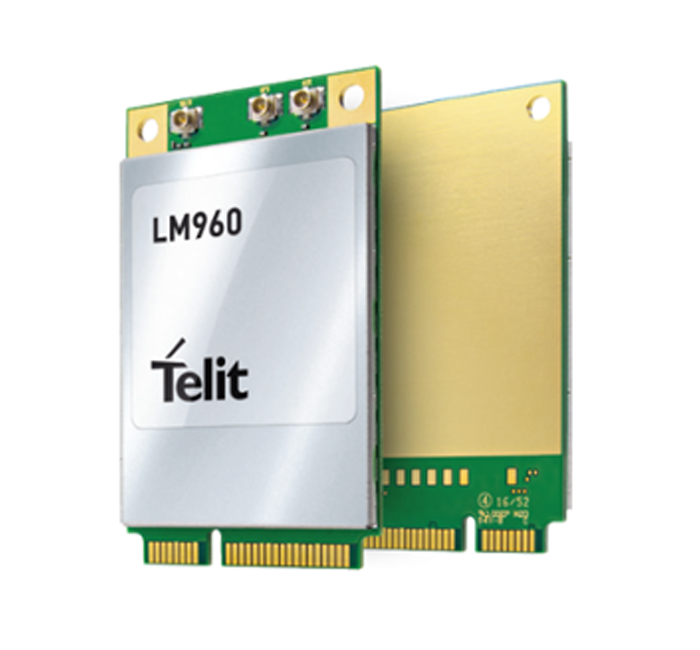 Specs Highlights: * World's first mPCIe form factor to support LTE cat.18 * Support global 23 LTE Frequency bands * LTE peak download speed up to 1Gbps * Dual SIM Single Standby * Full GNSS support: GPS, GLONASS, Galileo, Beidou * Chipset: Qualcomm Snapdragon X20 modem * Linux and Windows driver support * 4 x 4 MIMO and 256 QAM * 5x Carrier Aggregation for increased data rates Check more details about Telit LM960 Specs, price, drivers, and buy Telit LM960 module here: https://www.4gltemall.com/telit-lm960-4g-lte-cat18-pcie-module.html
Specs Highlights: * World's first mPCIe form factor to support LTE cat.18 * Support global 23 LTE Frequency bands * LTE peak download speed up to 1Gbps * Dual SIM Single Standby * Full GNSS support: GPS, GLONASS, Galileo, Beidou * Chipset: Qualcomm Snapdragon X20 modem * Linux and Windows driver support * 4 x 4 MIMO and 256 QAM * 5x Carrier Aggregation for increased data rates Check more details about Telit LM960 Specs, price, drivers, and buy Telit LM960 module here: https://www.4gltemall.com/telit-lm960-4g-lte-cat18-pcie-module.html - Sierra Wireless AirPrime EM7565 (LTE Cat.12)
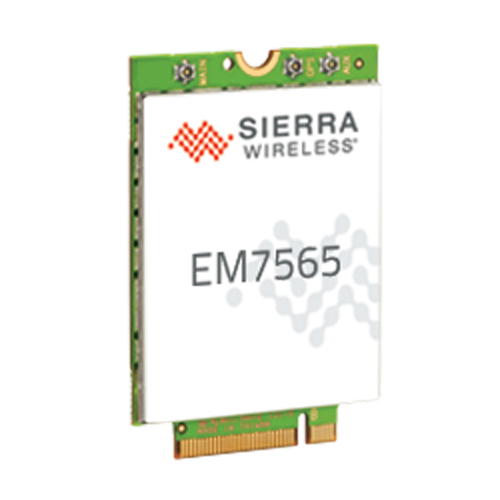 Specs Highlights: * LTE Advanced Pro Cat.12 Module * Chipset/Processor: Qualcomm MDM9250 * DL to 600Mbps/UL to 150Mbps * Supporting 24 worldwide LTE bands, including LTE-LAA and CBRS * Satellite Systems: Galileo, Glonass, GPS, Beidou * Planned Carrier AT&T, DoCoMo, Telstra, Verizon, Vodafone * Regulatory: CE, FCC, GCF, IC, NCC, PTCRB Check more details about Sierra AirPrime EM7565 Specs, price, drivers, and buy AirPrime EM7565 module here: https://www.4gltemall.com/sierra-wireless-airprime-em7565.html
Specs Highlights: * LTE Advanced Pro Cat.12 Module * Chipset/Processor: Qualcomm MDM9250 * DL to 600Mbps/UL to 150Mbps * Supporting 24 worldwide LTE bands, including LTE-LAA and CBRS * Satellite Systems: Galileo, Glonass, GPS, Beidou * Planned Carrier AT&T, DoCoMo, Telstra, Verizon, Vodafone * Regulatory: CE, FCC, GCF, IC, NCC, PTCRB Check more details about Sierra AirPrime EM7565 Specs, price, drivers, and buy AirPrime EM7565 module here: https://www.4gltemall.com/sierra-wireless-airprime-em7565.html - Sierra Wireless AirPrime EM7511 (LTE Cat.12)
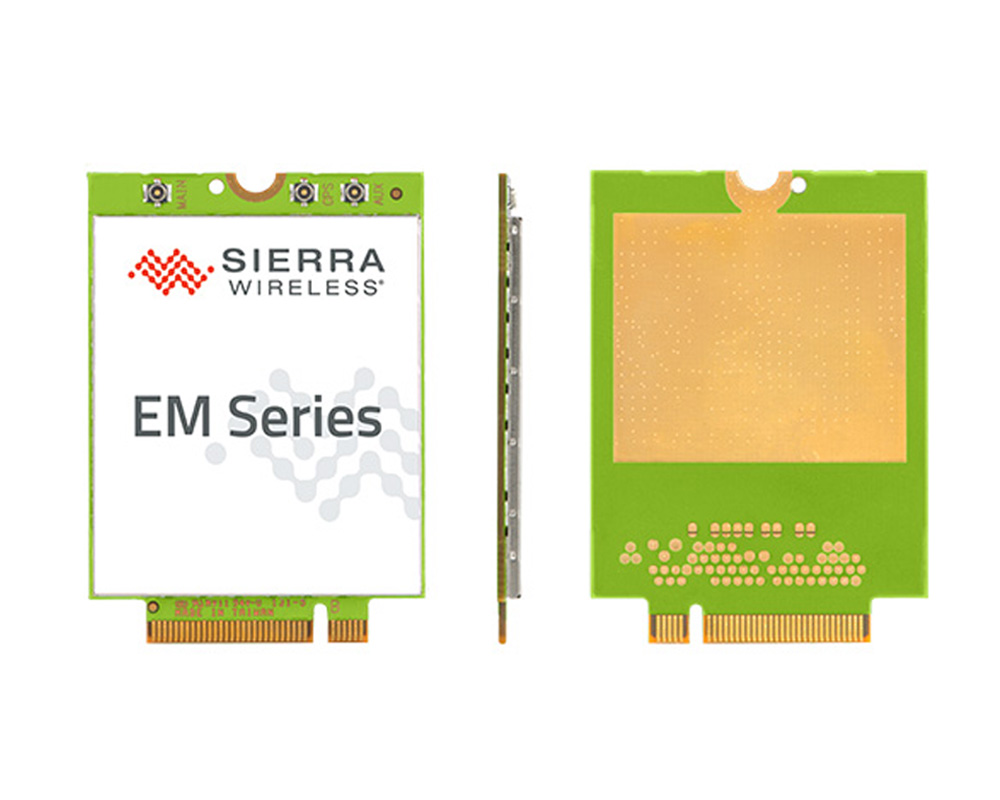 Specs Highlights: * Very similar to AirPrime EM7565 * LTE Advanced Pro Cat.12 Module * Form factor: M.2 * Chipset/Platform: Qualcomm * DL to 600Mbps/UL to 150Mbps * Supporting 24 worldwide LTE bands, including LTE-LAA and CBRS * Control Options: APIs, AT Commands * Firmware over-the-air (FOTA) * GPS, GLONASS, BeiDou, and Galileo satellite systems supported Check more details about Sierra AirPrime EM7511 Specs, price, drivers, and buy AirPrime EM7511 module here: https://www.4gltemall.com/sierra-wireless-airprime-em7511.html
Specs Highlights: * Very similar to AirPrime EM7565 * LTE Advanced Pro Cat.12 Module * Form factor: M.2 * Chipset/Platform: Qualcomm * DL to 600Mbps/UL to 150Mbps * Supporting 24 worldwide LTE bands, including LTE-LAA and CBRS * Control Options: APIs, AT Commands * Firmware over-the-air (FOTA) * GPS, GLONASS, BeiDou, and Galileo satellite systems supported Check more details about Sierra AirPrime EM7511 Specs, price, drivers, and buy AirPrime EM7511 module here: https://www.4gltemall.com/sierra-wireless-airprime-em7511.html - Telit LM940 (LTE Cat.11)
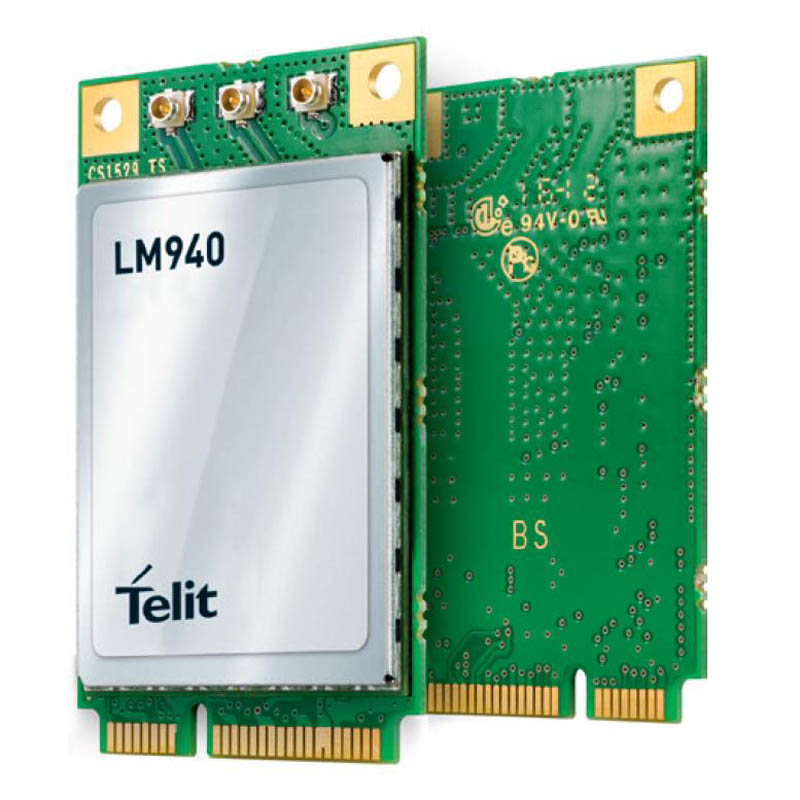 Specs Highlights: * Category: LTE Cat.11 Module * Form Factor: PCI Express Mini Card Type (mPCIe) * Chipset: Qualcomm MDM9240 * LTE data rates: DL 600Mbps(w/3x CA DL, 256QAM) and UL 75Mbps * Full GNSS support: GPS, GLONASS, Galileo, Beidou * Carrier Approvals: AT&T, Sprint, Verizon Check more details about Telit LM940 Specs, price, drivers, and buy Telit LM940 module here: https://www.4gltemall.com/telit-lm940-lte-cat-11-gps-pcie-module.html
Specs Highlights: * Category: LTE Cat.11 Module * Form Factor: PCI Express Mini Card Type (mPCIe) * Chipset: Qualcomm MDM9240 * LTE data rates: DL 600Mbps(w/3x CA DL, 256QAM) and UL 75Mbps * Full GNSS support: GPS, GLONASS, Galileo, Beidou * Carrier Approvals: AT&T, Sprint, Verizon Check more details about Telit LM940 Specs, price, drivers, and buy Telit LM940 module here: https://www.4gltemall.com/telit-lm940-lte-cat-11-gps-pcie-module.html - Telit LN940 (LTE Cat.11 and Cat.9)
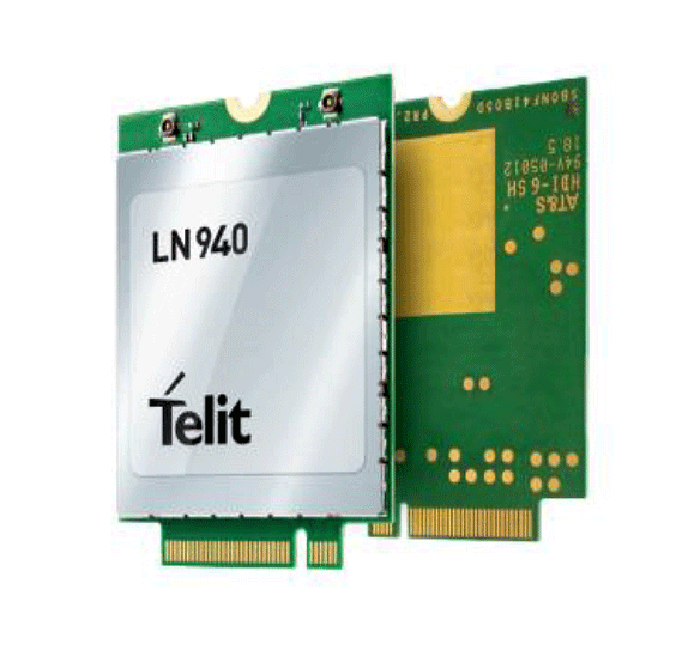 Specs Highlights: * Two variant models: Telit LN940A9 and LN940A11 * 42mm M.2 (NGFF) single-sided data card * LTE Category 11 LTE DL 600Mbps UL50Mbps * LTE Category 9 LTE DL 450Mbps UL50Mbps * HSPA + Rel. 8: DL / UL up to 42 / 11.5 Mbps * Quad-constellation integrated GNSS * Linux and Windows driver support * Carrier Aggregation, 2 x 2 MIMO and 256 QAM More details about Telit LN940 Specs, price, drivers, and buy Telit LN940 here: https://www.4gltemall.com/telit-ln940-lte-cat9-11-m-2-data-card.html
Specs Highlights: * Two variant models: Telit LN940A9 and LN940A11 * 42mm M.2 (NGFF) single-sided data card * LTE Category 11 LTE DL 600Mbps UL50Mbps * LTE Category 9 LTE DL 450Mbps UL50Mbps * HSPA + Rel. 8: DL / UL up to 42 / 11.5 Mbps * Quad-constellation integrated GNSS * Linux and Windows driver support * Carrier Aggregation, 2 x 2 MIMO and 256 QAM More details about Telit LN940 Specs, price, drivers, and buy Telit LN940 here: https://www.4gltemall.com/telit-ln940-lte-cat9-11-m-2-data-card.html -
Netgear Nighthawk M1 Mobile LTE Router Review
The Netgear Nighthawk M1 is a mobile LTE router designed to provide fast Internet access. In addition, it offers some interesting features, which we will explain in the following article in more detail.

Nighthawk M1 Overview
If you also want to use the Internet on your smartphone or tablet, you need a SIM card slot or use your smartphone as a hotspot, or you can get a mobile router like the Netgear Nighthawk M1 . The LTE network is designed to allow mobile Internet access for devices without LTE modem .
Technical specifications
Standard WLAN
WLAN 802.11 b / g / n 2.4 GHz; WLAN 802.11 a / n / ac 5 GHz
MIMO
4 × 4 MIMO
Frequency bands
LTE CAT. 16, LTE Advanced 4-band CA.
Up to 4X Carrier Aggregation
LTE / 4G 700/800/900/1800/2100/2300/2500/2600 MHz
3G 850/900/1900/2100 MHz
Chipset
Qualcomm MDM9x50
Connections
1x Ethernet, 1x USB Type A, 1x USB Type C
Dimensions
105.5 x 105.5 x 20.35 mm
Weight
240 g
Package Content
- Netgear Nighthawk M1
- Replaceable lithium-ion battery (Li-ion)
- AC charger and USB cable type C
- Quick start Guide

Design & Features
The Netgear Nighthawk M1 measures 105.5 x 105.5 x 20.35 millimeters and is therefore small enough to go through as a mobile router. The case is made of plastic, with battery; the router brings a weight of 240 grams. On the top there is a circular screen that provides information about data usage, number of connected devices, connection status and battery level. The upper plastic frame contains the power button, which is also used to navigate through the various displays on the screen.
The ports are integrated into the lower part of the frame, including an Ethernet port and a USB Type A and Type C port. Both USB ports allow you to connect external media to share the files on the network of the Nighthawk M1. The Type C connector is also used to charge the battery, whereas the Type A connector can charge other mobile devices. The connectors are flanked by TS-9 connectors for optional 4G/3G antennas. When not in use, the connections are protected by a cover.
The back cover can be removed to expose the replaceable 5.040 mAh battery. Below the battery is the slot for a micro SIM card. The test also worked well with a Nano SIM card, as long as it is correctly positioned on the contact points. A microSD card slot is also included, which can be used, for example, to stream movies or other files through the Netgear Nighthawk M1.
The interior is simple and can be completed in a few minutes. In the first step, a device (notebook, smartphone, tablet) must connect to the Netgear Nighthawk M1 via WLAN. The network name and key can be found on the screen of the router. Thereafter, the control access takes place on mobile devices, at best via the Netgear Mobile App and on PCs and notebooks via the web browser.
Accessing the Nighthawk M1 requires entering a username and password that can be set at first login. Subsequently, only the SIM card must be unlocked by PIN and the router is ready for use. Versatile settings can be made in the app or web interface, such as whether the router is to build a 2.4 GHz and 5 GHz WLAN or instead only one network should be active. In addition, the SSID and the password can be changed or a monthly consumption overview including data limit can be set up. Owners of an Arlo home security system are pleased to use the Nighthawk M1 as a base station for the Arlo cameras.

We tested the Netgear Nighthawk M1 in Vodafone LTE network. Since Gigabit LTE is only offered in a few German cities so far, we could only check how the mobile router beats in the "normal" LTE network. A Samsung Galaxy S9 connected via Wi-Fi to the router achieved 39.6 Mbps in the upload and 57.3 Mbps in the download. When we ran the speed test on a Dell XPS 13 (9360), the speed was increased to 104 Mbps in the download. The upload value was at 47.9 Mbit/s. For comparison, we ran the speed test with the same SIM card in the Galaxy S9. This could reach 85.4 Mbit/s in the download and 33.4 Mbit/s in the upload.

The Netgear Nighthawk M1 is ideal for use as a media server with its USB ports and microSD card slot. In the test, a UHD video could easily be streamed to the Galaxy S9. Only when fast-forwarding, the buffer had to be recharged, which has led to a few seconds of waiting time. For Full HD videos, streaming was possible with up to three devices simultaneously.
Conclusion
The Netgear Nighthawk M1 is the ideal companion for those who need an Internet connection on the go. In the LTE network, the mobile router provides a wide range of devices with high speed Internet access. The set-up is easy to do and can be made in the app. Another practical option is to use the Netgear Nighthawk M1 as a media server. You can use one of the two USB ports or the integrated microSD card slot. In addition, the USB Type A port can charge other devices. Owners of the Arlo security system can even use the Arlo security cameras. The Netgear Nighthawk offers many features and can certainly convince in the test. However, as a mobile WLAN router, the Netgear Nighthawk M1 price is high now.
-
Netgear Aircard 810s vs Huawei E5885Ls-93a
More and more new Huawei LTE advanced pocket WiFi routers are available in the market, which would be a powerful competitor to the 4G modem from Netgear wireless. Huawei E5885 is a new 4G pocket WiFi router at the end of 2017. Netgear AirCard 810s was released in 2016 and has already been sold in Netgear 4G Routers. Someone may ask: what's the difference between the Huawei E5885 and Netgear AC810S? Which one to buy from the two mobile routers? In this article, we will review the appearance, interfaces, specs, prices, and other features to answer the questions.
AirCard 810 Huawei E5885 VS Appearance and Interfaces
Since the Aircard 810s was available in the market for around 2 years, you may already know the Netgear AC810s, which is the world’s first LTE cat.11 mobile hotspot. On the front, there is a 2.4-inch touchscreen with “Home” and “Back” buttons at the screen side. The touchscreen allows users to do simple settings for internet connection. The power button is on the top edge side while on the opposite side, two connectors for an external antenna and USB 3.0 port are located. Like other Netgear 4G WiFi routers, the two connectors are a TS-9 type. The back cover of the Aircard 810s could be opened and the battery is removable.
Huawei E5885 may not be as well-known as Aircard 810s but it has unique features. Here now the market has only the E5885Ls-93a available. Not sure whether there will be a new variant model available in near future. The Huawei E5885 is thicker than common 4G mobile hotspots because it has a large built-in battery of 6400mAh. There is also a small screen on the front, but not touchable. The power button and WPS button are on the top edge side of the Ethernet port and USB ports. You much open the cap to see the ports. However, unlike other Huawei mobile router 4G, the Huawei E5885 doesn’t have the connectors for external antennas. The back cover could be removed but the built-in battery can’t be removed. The Huawei E5885 and Netgear Aircard 810s both use Micro SIM card size. The E5885 has also the Micro SD card slot for storage.
Netgear AirCard 810s vs Huawei E5885Ls-93a Specs and Features
From the appearance, we can see the Huawei E5885 and Netgear Aircard 810s are very different. Then let’s have a review about the Huawei E5885Ls-93a specs and Netgear AC810S specs.
Model Huawei E5885Ls-93a Netgear Aircard 810s Product type LTE Mobile Hotspot with Ethernet port LTE Mobile Hotspot Category LTE Cat.6 LTE Cat.11 Chipset Hisilicon LTE Cat6 chipset Qualcomm Snapdragon X12 Data rates DL 300Mbps/UL 50Mbps DL 600Mbps/UL 100Mbps Supported 4G LTE frequency bands * FDD-LTE Band 1/2/3/4/5/7/8/19/20/28 * TDD-LTE: Band 38/40/41/42 B1, B3, B7, B8, B28 WLAN 802.11a/b/g/n/ac, dual-band 2.4GHz & 5GHz 802.11a/b/g/n/ac, dual-band 2.4GHz & 5GHz Max support users 32 users 15 users MIMO 2 X 2 MIMO 2 x 2 MIMO Connector for external antenna No connector Two, TS-9 jacks Buy Antenna N/A Aircard 810s External Antenna App management Huawei Hilink APP 3.0 Netgear Aircard APP SIM type Micro SIM Micro SIM Battery Non-removable, 6400mAh Removable, 2930 mAh Dimensions 112.00 x 69.20 x 23.00mm 112 x 68.6 x 15.45mm Ethernet Port On port for WAN/LAN port(RJ-45) No Datasheet download Huawei E5885Ls-93a Datasheet Netgear AC810S Datasheet User Manual Huawei E5885Ls-93a User Manual Netgear AC810S Manual Other features Power bank, CA, NFC 3 band CA Reviews Huawei E5885 Review Netgear Aircard 810s review Price 249.00USD 249.00USD Summary
From the specs table, we can see the new Huawei E5885Ls-93a 4G hotspot supports LTE category 6 while the old model Netgear 810S supports LTE Cat.11, which could achieve almost double faster speed than that of Huawei E5885. However, the Huawei E5885 has many features that are very powerful. Firstly, the Huawei E5885 has one Ethernet port for WAN and LAN, which would provide more connection possibility, especially when the 4G connection is not available and only an Ethernet connection is available. Secondly, the Huawei E5885Ls-93a could support maximum users up to 32 users while Netgear Aircard 810s supports only 15 users. Thirdly, the Huawei E5885Ls-93a has a large battery pack of 6400mAh, which would keep working for a long time and charge other devices. The AirCard 810s also has the JumpBoost, which is to charge devices. However, the battery of 2930mAh seems weaker than Huawei E5885 battery.
However, the more advanced Netgear 810S has the latest Huawei E5885. If you need a practical 4G mobile WiFi hotspots, Huawei E5885 seems to be more powerful and useful. But if you just need a faster internet connection, the Netgear Aircard 810s is the right one to recommend.
Sourcing from https://www.4gltemall.com/blog/netgear-aircard-810s-vs-huawei-e5885/
-
Huawei E5787 VS Huawei E5885
After the releasing of Huawei E5786 - World's first LTE cat.6 mobile hotspot, Huawei introduced two new LTE Cat.6 mobile routers Huawei E5885 and E5787 last year for LTE advanced networks. Then here comes the question: why did Huawei present two new LTE Cat.6 mobile hotspots almost at the same time? What's the difference between Huawei E5787 and E5885? Which one is better to buy if you want to buy one from the Huawei 4G Wireless Routers ? In this article, we will compare the difference between E5887 and E5885 and you may find the answer.
Huawei E5787 Huawei E5885 VS Appearance and Interfaces
Upgrading from Huawei E5786 hotspot 4G, Huawei E5787 MiFi is configured with a 2.4-inch touchscreen with two connectors for external antennas. So it’s also called Huawei Mobile WiFi Touch. The connector type is TS-9. The back cover of Huawei E5787 can be opened and the battery is removable for exchange. There is only a power button on the top edge side and on the opposite side, there is a USB 3.0 port.
Unlike the Huawei E5787, the Huawei E5885 doesn’t have a touchscreen. There is only a small LCD screen to show the connection status. And there are also no connectors in Huawei E5885 for external antennas. The special feature of Huawei E5885 is that it has an Ethernet port for WAN & LAN connections. And USB input and output ports are available for power charging. With the interfaces, the WPS and power buttons are located. The back cover could be removed but the battery is built-in and non-removable. The features are very similar to its predecessor Huawei E5770 Mobile WiFi Pro.
Huawei E5885 VS Huawei E5787 Specifications
From the appearance, we can see the interface difference: Huawei E5885 has an Ethernet port and USB input and output interfaces, but no external antenna connectors; Huawei E5787 has a touchscreen and two TS-9 connectors for high gain 4g antenna but doesn’t have the Ethernet port. Then let’s have a look at the Huawei E5885Ls-93a specs and Huawei E5787 Specs for a comparison:
Model Huawei E5787 Huawei E5885Ls-93a Product type LTE Mobile Hotspot LTE Mobile Hotspot with Ethernet port Category LTE Cat.6 LTE Cat.6 Chipset HiSilicon LTE Cat6 Chipset (Cortex A9 Processor) Hisilicon LTE Cat6 chipset Data rates DL 300Mbps/UL 50Mbps DL 300Mbps/UL 50Mbps Supported 4G LTE frequency bands * Huawei E5787s-33a: Band 1/3/5/7/8/20 * Huawei E5787Ph-67a: Band 1/3/5/7/8/28 * FDD-LTE Band 1/2/3/4/5/7/8/19/20/28 * TDD-LTE: Band 38/40/41/42 WLAN 802.11a/b/g/n/ac, dual-band 2.4GHz & 5GHz 802.11a/b/g/n/ac, dual-band 2.4GHz & 5GHz Max support users 10 users 32 users MIMO 2 X 2 MIMO 2 X 2 MIMO Connector for external antenna Two, TS-9 jacks No connector Buy Antenna Huawei E5787 external Antenna N/A App management Huawei Hilink APP Huawei Hilink APP 3.0 SIM type Micro SIM Micro SIM Battery Removable, 3000mAh Non-removable, 6400mAh Dimensions 109.00 x 58.00 x 7.50mm 112.00 x 69.20 x 23.00mm Ethernet Port No On port for WAN/LAN port(RJ-45) Datasheet download Huawei E5787 Datasheet Huawei E5885 Datasheet User Manual Huawei E5787 Manual Huawei E5885Ls-93a Manual Other features 2 band CA Power bank, CA, NFC Reviews Huawei E5787 Review Huawei E5885 Review Price 269.00USD 249.00USD Summary
From the specs table above, we can see the Huawei E5885 and E5787 are both LTE Category 6 mobile WiFi hotspots which could achieve download speed up to 300mbps and upload speed to 50mbps. They both have the same WLAN features. The Huawei E5787 could support maximum up to 10 users while Huawei E5885 could support up to 32 WiFi users. Except that the antenna connector difference, the Huawei E5885 has a large battery pack of 6400mAh while Huawei E5787 is configured with only 3000mAh battery. The large battery of Huawei E5885 could make it work like a mobile power bank to charge other electric devices such as Pads, tablets, smartphone etc…And Huawei E5885 allows quick connection to its WiFi via NFC. The pity is that Huawei E5885 doesn’t have the antenna connectors for LTE antenna.
Here now Huawei E5787 WiFi router Has Two variant models while Huawei e5885 HAS only one variant model E5885Ls-93a. From the supported frequency bands, we can not tell which is better. It depends on the potential users 'network providers' networks. And Huawei E5885LS-93a seems to work with more network carriers worldwide. In our opinion, the Huawei E5885 seems to be more powerful and practical for users. What's more, it has a better price than that of Huawei E5787. However, you need to decide yourself.
Sourcing from https://www.4gltemall.com/blog/huawei-e5787-vs-huawei-e5885/

